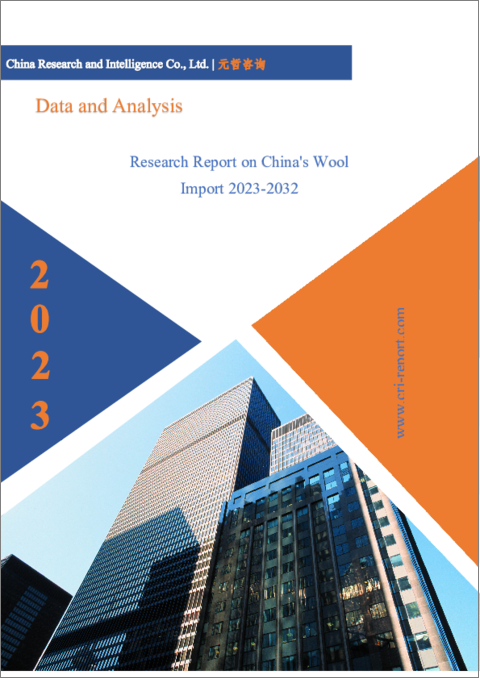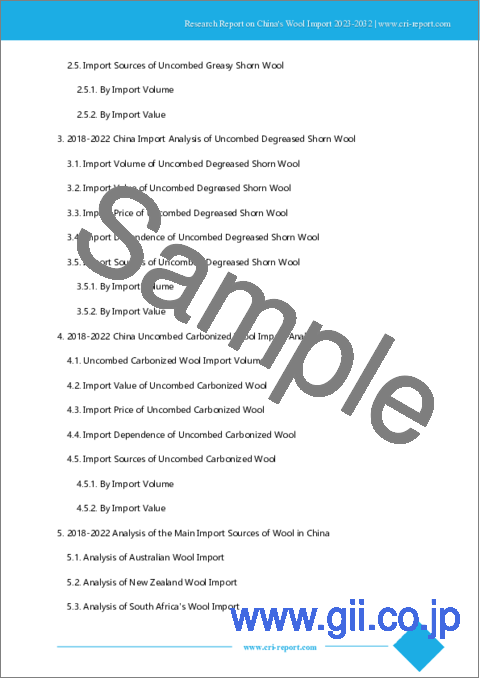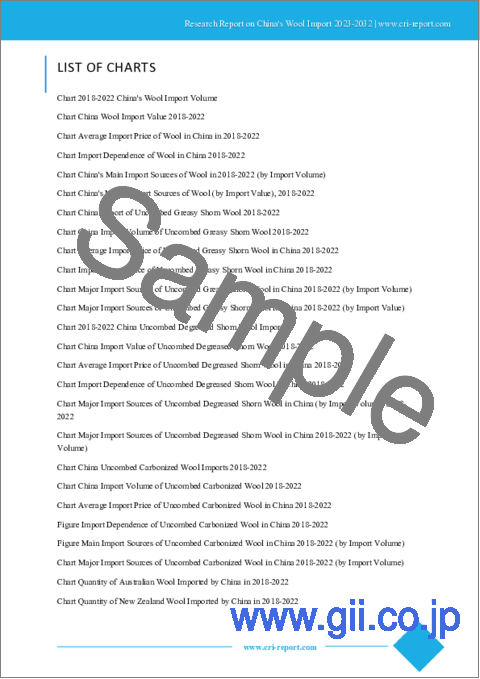|
|
市場調査レポート
商品コード
1162448
中国の羊毛輸入の分析 (2023年~2032年)Research Report on China's Wool Import 2023-2032 |
||||||
| 中国の羊毛輸入の分析 (2023年~2032年) |
|
出版日: 2022年11月22日
発行: China Research and Intelligence
ページ情報: 英文 60 Pages
納期: 即日から翌営業日
|
- 全表示
- 概要
- 目次
中国経済の発展と生活水準の向上に伴い、中国市場における羊毛の需要は増加の一途をたどっています。飼育可能な土地が限られているため、中国国内での羊毛生産はほとんど伸びず、中国は毎年大量の羊毛を輸入する必要があります。中国は世界最大の繊維・衣料品生産国ですが、羊毛などの繊維原料を毎年大量に輸入しています。
サンプルビュー
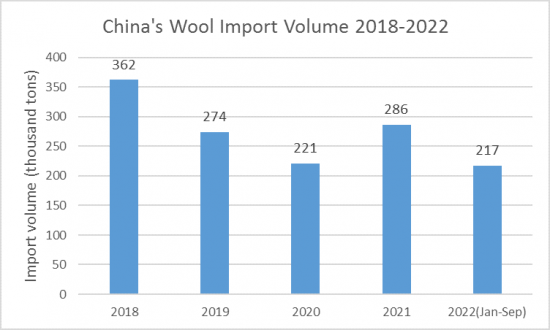
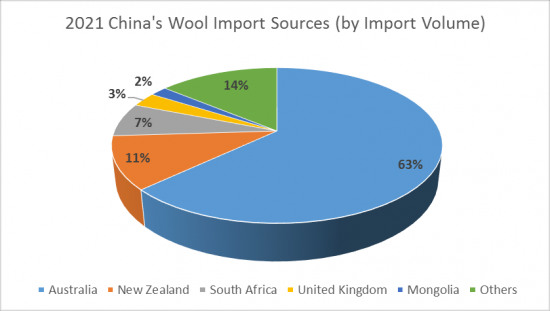
2021年、中国は28万6000トンの羊毛 (コームしていない羊毛、以下同じ) を輸入し、輸入額は24億米ドル (前年比47.9%増) となっています。2022年第1~3四半期の中国への羊毛輸入量は21万7,000トン (前年同期比3.8%減)、輸入額は17億3,000万米ドル (同8.8%減) でした。
中国の羊毛輸入の平均価格は2018年~2022年にやや変動した後、2018年~2019年は比較的安定しており、2020年は1kgあたり7.3米ドルに低下しました (前年比16.1%減)。2021年の平均価格は1kgあたり8.4米ドルに上昇しています (前年比14.5%増)。2022年の第1~3四半期には、平均輸入価格は再び下落して、1kgあたり8.0米ドルになります。
2021年、中国は未コーム・未脱脂剪毛を24万4,000トン (全体の85.4%)・23億2,000万米ドル (同96.7%) 輸入しました。
2021年、中国は世界38ヶ国から羊毛を輸入しました。主な供給国はオーストラリア、ニュージーランド、南アフリカ、英国、モンゴルで、この5カ国からの羊毛輸入量は全体の85%以上を占めています。2021年、中国はオーストラリア産の羊毛を18万1,000トン (輸入全体の63.3%)・18億9,000万米ドル分 (同78.9%) 輸入しました。
中国は世界最大の羊毛消費国であり、羊毛需要の増加に伴い、中国国内の羊毛生産量が加工市場の需要に追いつかず、結果として中国の羊毛輸入量が拡大し、輸入依存度が徐々に高まっています。2023年から2032年にかけて、中国は引き続き羊毛を輸入すると予想しています。
当レポートでは、中国の羊毛輸入市場について分析し、全体的な輸入量・輸入額や主な輸入先 (2018年~2022年)、種類別の詳細動向、輸入価格の推移、主な市場促進・抑制要因、主要企業のプロファイルと戦略、今後の輸入動向の見通し (2023年~2032年)、といった情報を取りまとめてお届けいたします。
目次
第1章 中国の羊毛輸入の分析 (2018年~2022年)
- 中国の羊毛の輸入規模
- 中国の羊毛の輸入量
- 中国の羊毛の輸入額
- 中国の羊毛の輸入価格
- 中国の羊毛の見掛け消費量
- 中国の羊毛の輸入依存度
- 中国の羊毛の主な輸入元
- 輸入量
- 輸入額
第2章 中国の未コーム・未脱脂剪毛の輸入分析 (2018年~2022年)
- 輸入量
- 輸入額
- 輸入価格
- 輸入依存度
- 輸入元
- 輸入量
- 輸入額
第3章 中国の未コーム・脱脂剪毛の輸入分析 (2018年~2022年)
第4章 中国の未コーム・炭化羊毛の輸入分析 (2018年~2022年)
第5章 中国の羊毛の主な輸入元の分析 (2018年~2022年)
- オーストラリアからの羊毛の輸入分析
- ニュージーランドからの羊毛の輸入分析
- 南アフリカからの羊毛の輸入分析
- 英国からの羊毛の輸入分析
- モンゴルからの羊毛の輸入分析
- 他の国々からの羊毛の輸入分析
第6章 中国の羊毛輸入の見通し (2023年~2032年)
- 中国の羊毛輸入に影響を与える要因
- 有利な要因
- 不利な要因
- 中国の羊毛輸入の予測 (2023年~2032年)
- 輸入量の予測
- 輸入量の予測:主な輸入元別
- 輸入量の予測:主な種類別
With the development of China's economy and rising living standards, the demand for wool in the Chinese market is on the rise. Due to the limited arable land, there is little room for growth in China's local wool production, and China needs to import a large amount of wool every year. China is the world's largest producer of textiles and clothing. China imports large quantities of textile materials such as cotton and wool every year.
SAMPLE VIEW


In 2021, China imported 286,000 tons of wool (uncombed wool, the same below), up 29.2% year-on-year, and the import value was US$2.40 billion, up 47.9% year-on-year. 217,000 tons of wool were imported into China in the first three quarters of 2022, down 3.8% year-on-year, and the import value was US$1.73 billion, down 8.8% year-on-year.
The average price of China's wool imports fluctuates slightly in 2018-2022, with a relatively stable average price of wool imports in 2018-2019 and a decline in 2020 to US$7.3 per kg, down 16.1% y-o-y. According to CRI analysis, the average wool import price rises to US$8.4 per kg in 2021, up 14.5% y-o-y. The average wool import price falls again to US$8.0 per kg in the first three quarters of 2022.
The main types of wool imported into China are uncombed fat-bearing sheep's wool, uncombed degreased sheep's wool (uncarbonized) and uncombed carbonized wool. In 2021, China imported 244,000 tons of uncombed fat-bearing sheep's wool, accounting for 85.4% of total imports and US$2.32 billion, or 96.7% of total imports in that year.
The main types of wool imported into China are uncombed greasy shorn wool, uncombed degreased shorn wool (uncarbonized) and uncombed carbonized wool. In 2021, China imported 244,000 tons of uncombed greasy shorn wool, accounting for 85.4% of total imports and US$2.32 billion, or 96.7% of total imports in that year.
In 2021, China imported wool from 38 countries. According to CRI's analysis, China's major sources of wool imports by volume are Australia, New Zealand, South Africa, the UK and Mongolia, with wool imports from these five countries accounting for more than 85% of total imports. In 2021, China imported 181,000 tons of Australian wool, accounting for 63.3% of total imports and US$1.89 billion, or 78.9% of total imports that year.
China is the world's largest consumer of wool, and with increasing demand for wool, China's domestic wool production levels have been unable to meet processing market demand, resulting in an expansion of China's wool imports and a gradual increase in import dependence. CRI expects China to continue importing wool from 2023-2032.
Topics covered:
- China's Wool Import Status and Major Sources in 2018-2022
- What is the Impact of COVID-19 on China's Wool Import?
- Which Companies are the Major Players in China's Wool Import Market and What are their Competitive Benchmarks?
- Key Drivers and Market Opportunities in China's Wool Import
- What are the Key Drivers, Challenges, and Opportunities for China's Wool Import during 2023-2032?
- What is the Expected Revenue of China's Wool Import during 2023-2032?
- What are the Strategies Adopted by the Key Players in the Market to Increase Their Market Share in the Industry?
- What are the Competitive Advantages of the Major Players in China's Wool Import Market?
- Which Segment of China's Wool Import is Expected to Dominate the Market in 2032?
- What are the Major Adverse Factors Facing China's Wool Import?
Table of Contents
1. 2018-2022 China's Wool Import Analysis
- 1.1. China's Wool Import Scale
- 1.1.1. China's Wool Import Volume
- 1.1.2. China's Wool Import Value
- 1.1.3. China's Wool Import Price
- 1.1.4. China's Apparent Wool Consumption
- 1.1.5. China's Wool Import Dependence
- 1.2. China's Main Sources of Wool Import
- 1.2.1. By Import Volume
- 1.2.2. By Import Value
2. 2018-2022 China Import Analysis of Uncombed Greasy Shorn Wool
- 2.1 Uncombed Greasy Shorn Wool Import Volume
- 2.2 Import Value of Uncombed Greasy Shorn Wool
- 2.3 Import Price of Uncombed Greasy Shorn Wool
- 2.4 Import Dependence of Uncombed Greasy Shorn Wool
- 2.5 Import Sources of Uncombed Greasy Shorn Wool
- 2.5.1. By Import Volume
- 2.5.2. By Import Value
3. 2018-2022 China Import Analysis of Uncombed Degreased Shorn Wool
- 3.1 Import Volume of Uncombed Degreased Shorn Wool
- 3.2 Import Value of Uncombed Degreased Shorn Wool
- 3.3 Import Price of Uncombed Degreased Shorn Wool
- 3.4 Import Dependence of Uncombed Degreased Shorn Wool
- 3.5 Import Sources of Uncombed Degreased Shorn Wool
- 3.5.1. By Import Volume
- 3.5.2. By Import Value
4. 2018-2022 China Uncombed Carbonized Wool Import Analysis
- 4.1 Uncombed Carbonized Wool Import Volume
- 4.2 Import Value of Uncombed Carbonized Wool
- 4.3 Import Price of Uncombed Carbonized Wool
- 4.4 Import Dependence of Uncombed Carbonized Wool
- 4.5 Import Sources of Uncombed Carbonized Wool
- 4.5.1. By Import Volume
- 4.5.2. By Import Value
5. 2018-2022 Analysis of the Main Import Sources of Wool in China
- 5.1. Analysis of Australian Wool Import
- 5.2. Analysis of New Zealand Wool Import
- 5.3. Analysis of South Africa's Wool Import
- 5.4 Analysis of British Wool Import
- 5.5 Analysis of Mongolia Wool Import
- 5.6 Analysis of Other Wool Import
6. Outlook for China's Wool Import, 2023-2032
- 6.1 Factors Affecting China's Wool Import
- 6.1.1 Favorable Factors
- 6.1.2 Unfavorable Factors
- 6.2. China's Wool Import Forecast, 2023-2032
- 6.2.1 Import Volume Forecast
- 6.2.2. Major Import Sources Forecast
- 6.2.3. Major Imported Wool Types Forecast
